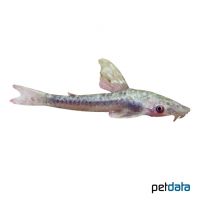Flat Head Dwarf Sucker (Hypoptopoma thoracatum)
| Flat Head Dwarf Sucker Hypoptopoma thoracatum | |
|---|---|
| Name | Flat Head Dwarf Sucker |
| Name Lat. | Hypoptopoma thoracatum |
| Family | Suckermouth Armoured Catfishes |
| Family lat. | Loricariidae |
| Order | Catfishes |
| Order lat. | Siluriformes |
| Origin | Peru, Bolivia |
| Habitat | Forest streams |
| Diet | Limnivore, soft wood |
| pH | 5.0-7.0 |
| Behavior | Peaceful |
| Keeping | Group |
| Care Level | Moderate |
| Reproduction | Substrate spawner |
| Breeding | None reported |
| Life Span | 3-5 years |
| Protection | No |
| Metric Units | |
| Size | 5-7 cm |
| Temperature | 23-27 °C |
| Hardness | 1-15 °dH |
| Aquarium | ~ 80 l |
| US Units | |
| Size | 2"-2.8" |
| Temperature | 73-81 °F |
| Hardness | 18-267 ppm |
| Aquarium | ~ 20 gal |
Distribution and habitat
Roach Hypoptopoma are common in tributaries of the Xebero River in the upper Amazon basin in Peru and the Rio Yapacani in Bolivia. They live in forest streams and small rivers with dense riparian vegetation among dead wood and aquatic plants.
Maintenance
The aquarium should have dense planting with roots that provide hiding places and at the same time are part of their diet. A sandy substrate, subdued light (floating plants) and a weak current is ideal
No ammonia, ammonium and nitrite should be detectable, the nitrate value should not exceed 100 mg/l. To ensure the water quality and oxygen content, a filter and heater adapted to the aquarium size is required, as well as lighting for the species-appropriate day-night rhythm of the animals.
Diet
They eat the vegetable cover (growth) of stones, wood, plants, etc. and the microorganisms contained therein. For a balanced diet, feed once a day with a high-quality dry food for loricariid catfish (granules, pellets, chips, tablets), supplemented with algae leaves, soft wood and fresh vegetables, such as zucchini, broccoli, bruised peas or scalded spinach, plus occasional small amounts of zooplankton, cyclops, daphnia, artemia, mosquito larvae, etc. (live or frozen)
Feed only as much as will be eaten within a few minutes, excluding plant foods. Regular and varied feeding promotes health and increases resistance.
Behaviour and compatibility
They are diurnal, live in small schools and are very suitable for a community tank with other peaceful fish. At least 5, but better more Red-eyed Hypoptopoma should be kept together.
Basically, only compatible fish species with similar demands on water condition and water temperature should be socialized.
Sex dimorphism
The sexes are difficult to distinguish. The females are slightly larger and rounder.
Reproduction and breeding
There are no known reports of successful breeding in aquaria.
Important
They are excellent algae cleaners, but aquarium plants are not damaged.
When catching them, use nets with as fine a mesh as possible so that the hard rays of the pectoral fins do not get caught.
The well-being of the fish should be checked regularly. Temperature should be checked daily, pH, hardness and nitrate levels at least every 14 days. Regular partial water changes are recommended, even if the contaminant level has not yet reached the upper limit. Sudden changes in water quality should be avoided. Newly introduced fish must be accustomed slowly to the water in the aquarium.
Further literature can be found in your pet store.
References
Text: Werner Winter; Image: petdata
Source: BMELV (1998): Tierschutzgutachten - Haltung von Zierfischen (Süßwasser); ENGELMANN (2005): Zootierhaltung - Tiere in menschlicher Obhut: Fische, Verlag Harri Deutsch
- Gemäß § 21 Abs. 5 Tierschutzgesetz idgF
